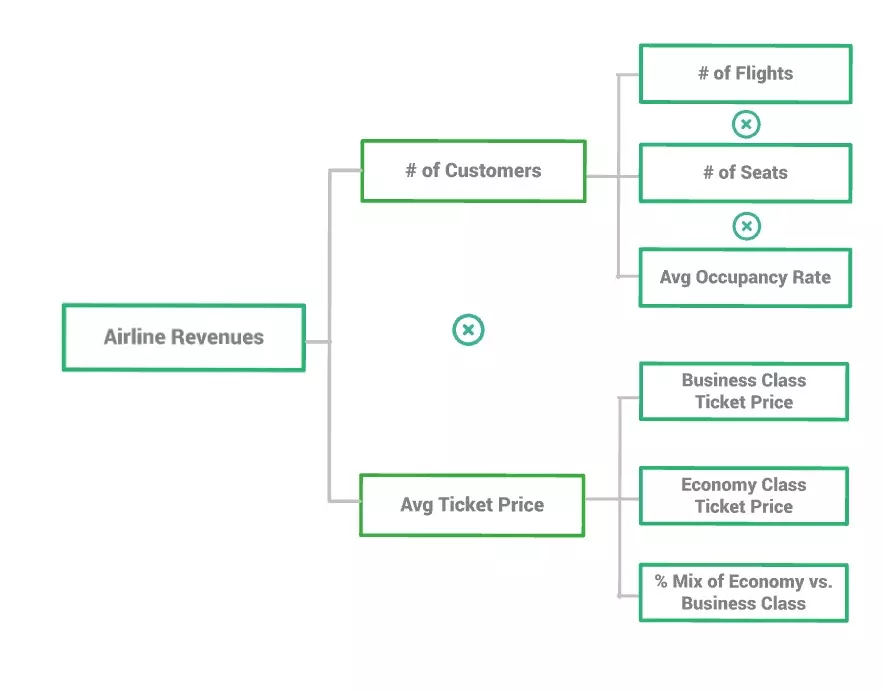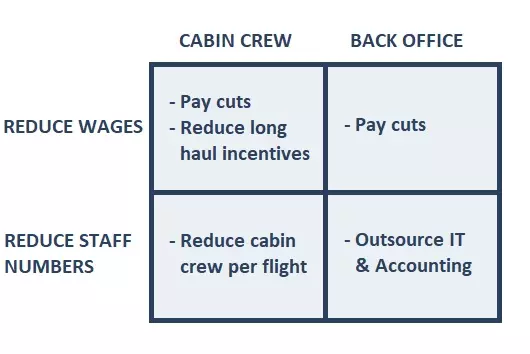After we have identified and segmented our case problem to draw up a priority driven structure, it is time to actually get down to business and generate a solution. We call this phase "leading the analysis". This is where you actually figure out your answer to the question you have been given.
There are two main steps to leading the analysis with MyConsultingCoach's priority driven structure method:
- Navigate your structure
- Generate solutions
We'll take a look at each step in turn, breaking down what you will need to do for each. To demonstrate how our method actually applies to a case, we'll take the example of a case where you have been asked to help an airline with a revenue problem. As well as discussing how to navigate the structure and how to properly approach generating solutions, we will also look at some places to look for inspiration when you think up those solutions.
This article offers a good primer on how to lead the analysis and should let you start applying our method to get better results in your case practice. However, it is impossible to be totally thorough in an article of this kind. Rather, the gold-standard resource in this area is our lengthy video lesson on leading the analysis in the MCC Academy. This is fully comprehensive, including more detail and going into more depth. The video lesson also works through more examples in much greater detail than we could hope to include here.
1. Navigate your structure
Your interviewer has given you a case prompt about an airline which has come to you with an issue around declining revenues. Let's say that you have done everything correctly so far in your case and have successfully both identified the problem and drawn up a valid priority driven structure. You might end up something like this:
(As a technical note, our method functions in the same way whether we have chosen to draw an hypothesis tree or an issue tree.)
So, how do we go from this structure with all its various elements to being in a position to generate solutions?
First, we need to have an idea of which of the factors identified in our structure is the correct one to focus on to produce a single solution to the case problem. For example, should we try to solve the airline's revenue problem by working on customer numbers or ticket prices? This is our fundamental objective in navigating a structure - to narrow down the area to which area we are actually going to address our solutions.
When we navigate our structure, we move from the fundamental question at the left to more and more specific factors at the right, continuing to expand the structure by segmenting relevant end nodes as required.
There might be a temptation to try and examine multiple branches of our structure at once. For example, a naive candidate might attempt to generate solutions by analysing both customer numbers and ticket prices simultaneously. However, this will be both enormously time consuming and confusing for both the candidate and the interviewer as they hop between different topics.
Join thousands of other candidates cracking cases like pros
At MyConsultingCoach we teach you how to solve cases like a consultant Get startedIn general, the key to success in navigating your structure is to doggedly maintain an hypothesis driven approach (if you have not read our article on this central consulting concept, you should do so now). We do this by repeating the same fundamental process, which we can divide into three stages: Hypothesis, Test and Iterate. We'll go through each of these stages in turn to show how you can reliably navigate your structure.
1.1. Hypothesise
Our first step is to hypothesise a root cause for the client's problem. This allows us to prioritise a specific branch of our structure. For our airline, we might hypothesise that the number of customers declined due to competition, and so focus on customer number for the time being.
1.2. Test
Next, we test this hypothesis. To do this, we must ask our interviewer for further information. As always, questions should be logical and focussed. For instance, to see whether our airline's revenue problem might be caused by competitors luring away our customers, we could ask if the number of customers has actually declined in the past two years. Avoid "laundry lists" of surplus questions or ill-considered queries which do not actually fully confirm or disprove your hypothesis.
1.3. Iterate
Finally, we iterate this process. If our hypothesis is confirmed, we follow this branch of the structure on to the next level, drilling down and making further segmentations as required. Thus, if the number of customers has indeed fallen in recent years, we will stay on this branch and move across to chose one of the as per our structure
If our hypothesis is disproven, though, we change our hypothesis, shifting our attention to another branch and beginning the process again. Thus, if customer numbers have not fallen, we will switch branches and examine how our ticket pricing might underlie the revenue issue.
This method is not some business gimmick, but is a powerful means of problem solving which can be applied well beyond the realms of consultancy. For those who are interested, it is possible to think about the hypothesis driven approach as an application of Karl Popper's falsificationist model of the scientific method. Just as scientists continue to work on theories until they are shown to be false and then move to another, so you will do the same as a consultant.
2. Generate Solutions
Now that you have narrowed down the specific area on which you want to focus your solutions, it is time to actually come up with some ideas! Of course, this is ultimately a business of imagination and it is inherently difficult to prescribe a rigid method for coming up with new ideas. (Indeed, you should be suspicious of anyone who tries to tell you that they have a single method for coming up with novel ideas - the idea of a pre-existing system as the reliable source of all new innovation is arguably incoherent.)
It should also be kept in mind that multiple different solutions might be sufficient to address the client's problem. Real-world businesses are complex entities and there will generally be many different ways of acting upon many different factors so as to yield the desired output in terms of aggregate level outputs like revenue. As the saying goes, there is more than one way to skin a cat.
As with so many things, just because there are many different ways to correctly come up with solutions, this does not mean that it is impossible to go about it in an incorrect way.
Returning to our airline example, after being prompted by their interviewer, a naive candidate might attempt to generate solutions as follows:
Interviewer - "How can our client increase its number of business class passengers?”
Candidate - "We could lower prices. Or we could improve our lounges. Or we could do partnerships with Companies. Or we could revamp our business class to be best in class in the world. I also know some airlines started introducing a premium economy cabin, so we could also explore that.”
Of course, some of these suggestions might well be perfectly valid. However, this is still the wrong way to go about generating solutions. This stream of ideas is neither structured and nor MECE. Furthermore, the suggestion about creating the best business class in the world is unlikely to be actionable for the client. The idea of a premium economy cabin is interesting in its own right, but does not actually address the core problem of business class travel.
Looking for an all-inclusive, peace of mind program?
Choose our mentoring programs to get access to all our resources, a customised study plan and a dedicated experienced MBB mentor Learn moreSo, how can we do things better? In contrast to the candidate above, you need to retain much of the same attitude as that associated with an hypothesis driven mindset when it comes to generating solutions. Looking at how the candidate above went wrong, we can identify three main requirements which you must pay attention to whichever way you chose to generate your solutions. These are:
2.1. Structured
It is crucial to make sure that you generate solutions in a logical, structured way. Ask for a few seconds to think to make sure you do this properly. We'll go into more detail about how you can structure your ideas below.
2.2. Tailored
It might seem obvious, but we must always make sure that our solutions actually address the client's problem, taking account of its specific character. This is a good place to apply the "peanut butter factory test". Ask yourself whether the solution your have arrived at could be applied equally well to any other business - such as a peanut butter factory - if so, it is probably not sufficiently tailored to your case.
2.3. Actionable and Realistic
Solutions which cannot actually be enacted are of no use to anyone. As such, we need always to pay attention to constraints which might apply. For instance, there might be financial or time constraints which mean that our proposed solution needs to turn a business around quickly before it goes bust or that there is only a limited amount of cash available to make changes.

Structure
The variability in correct ways to generate hypotheses derives from the fact that there are multiple valid ways to add such structure. Let's take a look at a few commonly used methods to approach structuring your ideas which can starting point for you to apply to cases.
Mathematical Breakdown
Just as with mathematical segmentation when building your priority driven structure, breaking elements down into their mathematical components can be a great way to arrive at solutions.
Take the staff costs for our airline. Mathematically, these can be calculated as the product of the average wage and the number of staff. Thus, we might reduce wage costs by making pay cuts, replacing senior staff with junior staff and/or reducing bonuses. We can reduce number of staff by measures such as cutting the number of flight attendants and outsourcing back office roles.
Matrix
Mathematical breakdowns will not always be possible or appropriate. Where they are not, a good way to structure solution generation is to employ a 2x2 matrix. For our airline example, a matrix of cost cutting measures might look like this:
Custom Structure
These two ways of structuring solution generation are far from the only way correct way of doing so. It might well be that the best way to generate solutions to your problem is with one customised specifically for the task in hand.
For example, below is a custom structure for our airline which divides cost cutting measures into three broad approaches:
However we decide to customise a structure, we must always make sure that that structure manifests the same generally rigorous, logical character we observe in the mathematical and matrix approaches above. In this custom structure, the three categories used are MECE whilst also being tailored to the case and clearly related to actionable recommendations. You should find that much of the content within our articles on segmentation and the MECE rule will be just as relevant here as they are to the process of building priority driven structures.
All the best resources in one place!
Our platform is unique in collecting everything you need to ace your interview in one convenient location, for a truly joined up experience. Sign upInspiration
Inspiration can come from anywhere, and is perhaps the most difficult component of generating new solutions to provide guidance on. Sometimes solutions will just occur to you out of nowhere. However, setting aside such bolts of genius emerging out of the blue, there are a few helpful methods which consultants will typically use to come up with solutions to the business problems they face. MyConsultingCoach has resources which can be very helpful in this area.
1. Competitor Benchmark
Businesses in the same industry will tend to face the same problems, so one way of finding solutions it simply to see how successful competitor companies have dealt with the same issue. Thus, we would say that we are seeking to replicate our competitor's best practices. Of course, companies are not identical and judgement must be applied as to whether competitor practices will actually be compatible with the client company. For example, our airline might try to cut staff costs by emulating Ryanair's strategy of hiring younger pilots - but this might conflict with a brand built around quality.
The "Fundamentals" section of our MCC Academy course is especially useful here in teaching you how to interpret various marketing, strategy and finance problems.
2. Translating from other industries
Competitor benchmarking borrows solutions from other players within the same industry. However, we do not need to limit our gaze to our own industry for possible inspiration. Often, we can find a level of analogy with businesses selling very different products which allow us to borrow a model and apply it to our own situation. For example, our airline might use an algorithm to recommend future trips to customers based on past ones, similar to how Spotify and other music platforms recommend new songs to users.
Our "Building Blocks" articles and comprehensive set of lessons in the MCC Academy are a great resource here, as they teach you about various themes and relationships which recur across various entirely disparate industries. These include issues related to pricing, valuation and profitability.
3. Business sense
Of course, the best solutions are often the simplest ones and the ones that come to mind naturally. To some extent, the solutions we generate intuitively will probably be based on an unconscious application of something like the above comparative methods. Whatever the case may be though, the way to develop your business sense is to constantly take in new information about all manner of business topics. Thus, you should be sure to keep up with the business press and to read and watch all you can about all kinds of business - even in industries you do not intend to work in. This does not have to be dull, and can include more "popular" sources. Even material which you read for interest which might not seem relevant now is all grist for the mill and might well turn out to make all the difference in that big MBB interview!

Takeaways
There are many different ways which we might generate solutions to any given problem. However, this does not mean that all are equally valid, and we must always make sure that our process for arriving at solutions is structured in an appropriate way. Here, we have looked at how to navigate a priority driven structure to efficiently narrow down the specific factors to which we should address a solution, before examining different methods which can help us actually formulate that solution.
As a crucial element of solution generation, inspiration is an especially nebulous phenomenon to pin down. However, we explored some generally useful methods to generate ideas which can be expected to yield useful ideas across many situations.
As mentioned in the introduction, it is impossible to be fully comprehensive in these relatively brief articles. Whilst we have given a good introduction to leading the analysis, which you can start to applying to your case practice right away, the best resource to learn how to lead the analysis is our video lesson on the subject in the MCC Academy.
There, we will also go through common mistakes in leading the analysis and work through additional examples of how to apply our method to cases. We also learn how the different approaches to interview taken by different firms (the interviewer-led approach taken by McKinsey vs the candidate-led approach at Bain) impact how you will lead the analysis in the specific kind of interview you have.
Once you have mastered leading the analysis, it is time to move on to the final stage of our four step process of case cracking - providing client recommendations. See you there!
Find out more in our case interview course
Ditch outdated guides and misleading frameworks and join the MCC Academy, the first comprehensive case interview course that teaches you how consultants approach case studies.









